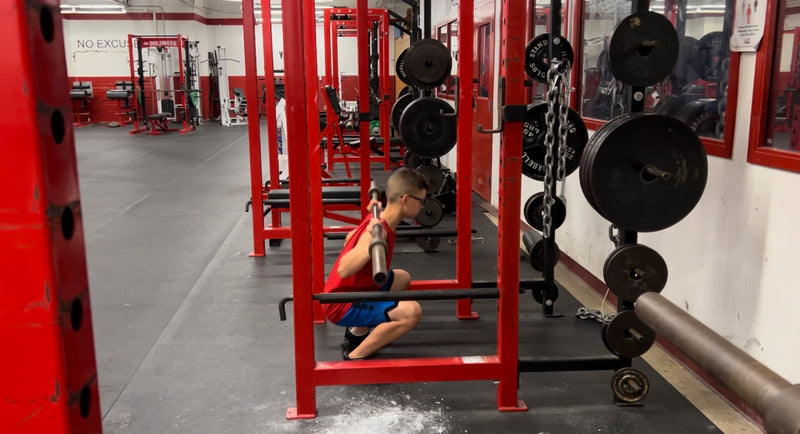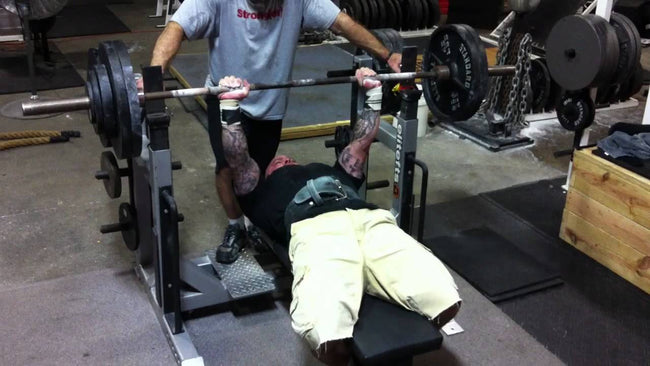A couple weeks ago during in-season training, the J.V. kids worked up on the trap bar. As you'd expect, everyone got stronger and did some stupid insane weights. Lots of smiles and "atta-boys!" And even after a couple of decades of this stuff, I'm still amazed at the difference between "training weights" and their "work up weights." I still call Rhodes and tell him - "You aren't going to believe this!" And 4 weeks later, Rhodes will call me and say, "Dude, this girl's TM was 135 and she just squatted 185 for 3 reps - with 3 in the tank." You'd think I'd learn! Which brings me to the next point.
A couple days after this, I got to thinking about the possibility of doing something similar every week. Larger groups (off-season) would be difficult to do but smaller groups of 12-20 kids could be manageable. All I had to do was watch each set and judge what weight they should do next. Theoretically, I could do this and the kids could then work up based on their readiness for the day. Simple! We could be hitting records all year! Then common sense came back and I realized that the reason they had such an awesome day is because they put in the work, month after month, of the "boring" work. The "work up day" was only successful because we spent the time raising the floor (and not the ceiling.)
This was only solidified when I spoke to some of the kids. While super happy, they were all pretty sore. And while I don't really concern myself with J.V. soreness, doing this week after week isn't a recipe for a successful athlete. Their training is bigger and broader than just the trap bar. And even if it wasn't - the next workout will be compromised even though it was just bench press/upper body training.
Which brings me to my second point - "block training" for high school athletes. I've seen this mentioned many, many times. Every so often a young athlete will ask, "What is the best football workout for me? I'm a high school player who needs to get bigger, stronger and faster." The typical response is something like:
- 6 weeks hypertrophy
- 4 weeks strength
- 4 weeks power/speed
- 2 weeks peak/skill
I don't know if the number of weeks is accurate but the point remains - a young athlete isn't going to make a dent with 6 weeks of hypertrophy training. As everyone here knows, it takes YEARS for a young athlete or any new lifter to develop. And while he might put on SOME muscle, 6 weeks of hypertrophy training isn't going to turn a 135lbs, 14 year old kid into a 185lbs monster. And 4 weeks to get stronger? Seriously?
So while it looks cool and scientific on paper, a young athlete (or really anyone new to training) needs a concurrent style of training. Concurrent is another word for "conjugate" - a term we all recognize due to Westside Barbell. Concurrent training is the raising of several abilities at once. If anyone ever read Supertraining, Siff points out that concurrent training is optimal for young/less experienced lifters. Because all abilities are low and it's simple to raise all of them at the same time. Not so much with a super advanced lifter. Young lifters can get stronger, put on muscle and get in better shape without a complicated "block" program. Imagine if a young athlete only did 2, 6 week blocks of hypertrophy training/year! It's ridiculous. (Especially when the same "block" people who claim that these same athletes need to only maintain their strength during all sport seasons. Good luck getting stronger/bigger if you are a 2 or 3 sport athlete.)
So what does this mean for the average, middle-aged dude who just wants to get better/more awesome? It means that if you want to put on muscle, you don't need to stop trying to get stronger/better shape in the process. You can still keep that stuff in the program - and while you may spend more time doing X, Y, Z - it doesn't mean you can't stop hitting some hard squats sets or riding the bike/running. It just has to be in balance! And remember "balance" doesn't mean equal time. It only means that you address the issue with what is necessary. As an example, if you want to raise your squat - your conditioning wouldn't be terribly intensive. Or your upper body training may be easier to allow for recovery. (The only caveat to this would be someone training specifically for a sport - much different goals and intentions.)
Finally, in regards to the "raise the floor/not the ceiling" mantra. As we all know, life has a funny way of coming full circle. It has been my experience that both younger lifters AND older lifters need to spend more time raising the floor. The young dudes need more great/solid reps done with sub-max weights and awesome form to reinforce their technique, focus on effort/speed/precision and not max out every week. The older dudes need more great/solid reps done with sub-max weights with awesome form to keep from getting hurt, staying fresh and to combat all the other stressors in life. Also, the older you are the more your strength is going to fluctuate from day-to-day. Sub-max training allows you to account for all of the trials of being an older dude and keeping you training consistently. Note: I think a lot of older lifters are not so much "raising the floor" as they are "don't let the floor fall out into a cavern of nothingness."
Make sure you are putting in the good work. It may take awhile to pay off but it'll be worth it.





